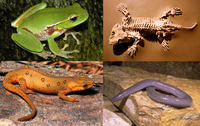
Photo from wikipedia
The prostate gland is a male accessory reproductive gland that requires androgenic steroids for maintaining its vitality and function. The aim of the study was to investigate the localization and… Click to show full abstract
The prostate gland is a male accessory reproductive gland that requires androgenic steroids for maintaining its vitality and function. The aim of the study was to investigate the localization and expressions of the androgen receptor (AR), SRD5A1 and SRD5A2 in the prostate glands of wild male ground squirrels during different reproductive periods by immunohistochemistry and real-time PCR. Gross mass of the prostate gland was higher in the breeding season than that of the non-breeding season. Histological observation showed that exocrine lumens in the prostate gland were enlarged in the breeding season and shrank in the non-breeding season. Immunohistochemical results demonstrated that AR was presented in both epithelial and stromal cells' nuclei during both the breeding and non-breeding seasons. Intriguingly, the positive staining of SRD5A1 and SRD5A2 was only found in the stromal cells. The mRNA expression of the three genes including Ar, Srd5a1 and Srd5a2 in the prostate gland was higher in the breeding season than those of the nonbreeding season. In addition, the circulating concentration of testosterone (T) and the concentration of dihydrotestosterone (DHT) in the prostate gland were also markedly higher in the breeding season than those of the nonbreeding season. These results suggest that expression levels of AR, SRD5A1 and SRD5A2, as well as DHT synthesis, might be correlated with seasonal changes in morphology and function of the prostate gland, indicating that DHT may serve as a pivotal regulator to affect the morphology and function of prostate gland via a autocrine/paracrine pathway in wild male ground squirrels.
Journal Title: Comparative biochemistry and physiology. Part A, Molecular & integrative physiology
Year Published: 2018
Link to full text (if available)
Share on Social Media: Sign Up to like & get
recommendations!